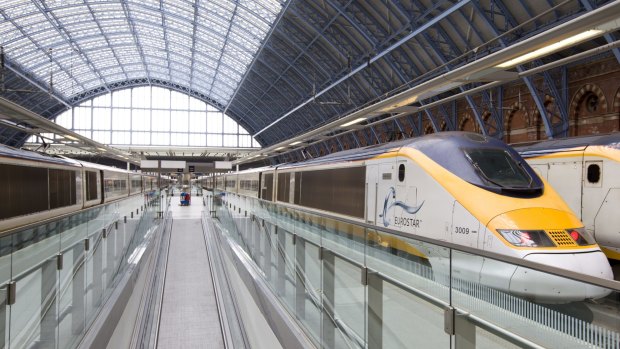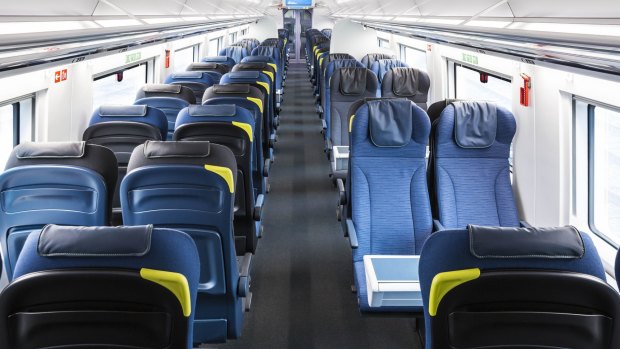This was published 4 years ago
Trains versus planes: In the era of 'flight shame' there's even more reason to travel by rail
By Ben Groundwater
There's nothing like a little public shaming to change travellers' bad habits. And right now, it's the good people of Sweden leading the way.
This year's Scandinavian word-of-the-moment, taking the baton from the cuddly likes of "hygge" (cosy) and "lykke" (happiness), is the Swedish mouthful "flygskam", which means, literally, "flight shame".
It's a word, and it's a movement. It's the idea that flying in planes isn't romantic or even impressive any more, but rather something that should be a source of shame. Planes pollute, creating the most carbon emissions on short-haul journeys of any mass transit option around. According to the flygskam proponents, you should be doing everything in your power to avoid boarding another flight.

Taking a Eurostar train from London to Paris saves you 2½ hours compared to flying.Credit: International Rail
And so with the shaming has come a shift away from air travel. A five per cent shift in Sweden. Elsewhere the change might be a little more subtle, but it's still there. Some travellers are trying to avoid planes. And they're opting, instead, for the humble, classic train.
Travel by rail is booming. The online booking platform Klook has seen triple-digit growth in rail travel in 2019. It reports that in the decade from 2011 to 2020, the rail industry in Europe, as a whole, will see a total increase in passenger volume on long-haul trains of 21 per cent.
That's not bad for a form of transport that could easily be seen as antiquated or twee. Trains have been carting passengers around the world since the early 1800s, and though the style of travel on board has changed, with most of the pomp and finery ditched in favour of speed and passenger volume, its popularity has done anything but wane.

Travel in comfort: On board the Eurostar.
Trains even have their own hashtags now, a sure sign of modern relevance. And it's the Swedes, once again, who have coined the hashtag campaigns #jagstannarpamarken and #tagskryt, which have English versions too: #stayontheground and #trainbragging. Going somewhere by train? Get bragging.
And I, personally, am ready to brag. I love train travel. I'm a total rail nerd, someone who geeks out over classic journeys and everything from old-school finery to modern wizardry. Some of the most memorable overseas trips I've been on – crossing Siberia, travelling through Thailand, creaking across India, shooting through Japan – have been by rail. Trains are an exciting, adventurous, enjoyable way to travel.
I'll always choose rail if I can, if it's available, if it's affordable, if it isn't going to rattle and roll and take a million hours to travel a few kilometres. Trains are more social. They're slower, too, and gentler – they allow you to look around, to appreciate the scenery, to see how one place morphs naturally into the next. They cut out the hassle of airports, all the queues and scanners and expense.
But there's more to the global shift towards train travel than that. A large part for the growing appreciation for wheels on rails is environmental. Travellers who care about carbon emissions and their effect on climate change will most definitely want to travel by train when they have the opportunity.
Trains produce fewer emissions that planes – they can use up to 50 per cent less fuel than a plane for a similar-length journey – and those emissions aren't released directly into the upper atmosphere, which is important.
Trains have also begun using renewable energy for power: this year Germany, Britain, Italy and France will begin testing solar panels that are housed in train tracks, and that could eventually be trains' sole source of power. Electric trains in the Netherlands are already powered 100 per cent by wind energy. Trains in Belgium are running in part on solar power.
That's a large driver. What's also helping trains' cause is their affordability, and their speed, which in some cases – particularly in Europe – can mean getting from A to B faster than if you flew.
According to Klook's calculations, for example, you'd save 2½ hours travelling by train from London to Paris. You would save an hour travelling from Paris to Amsterdam by rail. You'd pick up three hours going from Naples to Florence.
There's also the fact trains can get you to places planes can't: plenty of the small, off-the-beaten-track towns in Europe, in particular, that are now so much more attractive given the recent issues with over-tourism can only be reached by rail. Even if you elected to fly to the nearest airport, you would still have to make your way to train station to get there.
Those are the main attractions. And then there are the bragging rights; the #trainbragging. And, of course, the lack of shame.
Life on the rails is looking pretty good.
Have you begun travelling on trains more? Why? Environmental reasons? Or to save time and hassle? Where's the best place in the world to travel by train?
Email: b.groundwater@traveller.com.au
Instagram: Instagram.com/bengroundwater
See also: The world's greatest train journeys
Sign up for the Traveller Deals newsletter
Get exclusive travel deals delivered straight to your inbox. Sign up now.